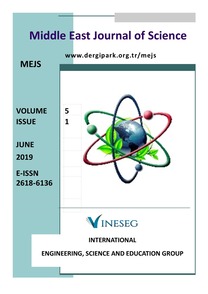EVALUATION OF TOTAL ORGANIC CARBON REMOVAL EFFICIENCY IN SANLIURFA DRINKING WATER TREATMENT PLANT
EVALUATION OF TOTAL ORGANIC CARBON REMOVAL EFFICIENCY IN SANLIURFA DRINKING WATER TREATMENT PLANT
___
- [1] Ledesma, J.L.J., Köhler, S.J., Futter, M.N., ‘‘Long-term dynamics of dissolved organic carbon: Implications for drinking water supply’’, Science of the Total Environment, 432, 1-11, 2012.
- [2] Anonymous, ‘‘Türkiye’de İçme Suyu Arıtımı, Yaşanan Problemler ve Çözüm Önerileri Kitabı’’, Orman Su İşleri Bakanlığı, Ankara, pp.114, 2017.
- [3] Niu, Z., Hu, X., Zhang, Y., Sun, Y., ‘‘Effect of chlorine dosage in prechlorination on trihalomethanes and haloacetic acids during water treatment process’’, Environmental Science and Pollution Research International, 24, 5068-5077, 2016.
- [4] Nieto-Sandoval, J., Munoz, M., Pedro, Z.M., Casas, J.A., ‘‘Catalytic hydrodechlorination as polishing step in drinking water treatment for the removal of chlorinated micropollutants’’, Separation and Purification Technology,227,115717, 2019.
- [5] Kumar, P., Hegde, K., Brar, S.K., Cledon, M., Kermanshahi, A., ‘‘Physico-chemical treatment for the degradation of cyanotoxins with emphasis on drinking water treatment-How far have we come?’’, Journal of Environmental Chemical Engineering, 6,5369-5388, 2018.
- [6] Rule, K.L., Ebbett, V.R., Vikesland, P., ‘‘Formation of chloroform and chlorinated organics by free-chlorine-mediated oxidation of triclosan’’, Environmental Science and Technology, 39, 3176-3185, 2005.
- [7] Soufan, M., Deborde, M., Legube, B., ‘‘Aqueous chlorination of diclofenac: kinetic study and transformation products identification’’, Water Research, 46, 3377-3386, 2012.
- [8] ODriscoll, C., Sheahan, J., Renou-Wilson, F., Croot, P., Pilla, F., Misstear, B., ‘‘National scale assessment of total trihalomethanes in Irish drinking water’’, Journal of Environmental Management, 212,131-141, 2018.
- [9] Benner, J., Helbling, D.E., Kohler, H., Wittebol, J., Brezina, E., Prasse, C., Ternes, T., Albers, C.N., Aamand, J., Horemans, B., Springael, D., Walravens, E., Boon, N., ‘‘Is biological treatment a viable alternative for micropollutant removal in drinking water treatment processes?’’, Water Research, 47, 5955-5976, 2013.
- [10] Bond, T., Huang, J., Templeton, M.R., Graham, N., ‘‘Occurrence and control of nitrogenous disinfection by-products in drinking water - a review’’, Water Research, 45, 4341-4354, 2011.
- [11] Yıldız, N., ‘‘Şanlıurfa İçme Suyu Sisteminin Kalite Kontrol Parametreleri Açısından İncelenmesi’’, Harran Üniversitesi, Fen Bilimleri Enstitüsü, Yüksek Lisans Tezi, Şanlıurfa, pp.75, 1996.
- [12] Kırıkçı, A., ‘‘Şanlıurfa İli İçme Suyunda Trihalometan Potansiyelinin Belirlenmesi’’, Harran Üniversitesi, Fen Bilimleri Enstitüsü, Yüksek Lisans Tezi, Şanlıurfa, pp.56, 2006.
- [13] Eroğlu, V., ‘‘Su Tasfiyesi’’, Çevre ve Orman Bakanlığı Yayını, Ankara, pp.407, 2008.
- [14] Uyak, V., Toröz, İ., ‘‘İçme suyu kaynaklarındaki doğal organik maddelerin zenginleştirilmiş koagülasyon yöntemi ile giderilmesi’’, İstanbul Teknik Üniversitesi Dergisi, 16, 115-122, 2006.
- [15] Gümüş, D., Akbal F., ‘‘Removal of Natural Organic Matter in Drinking Waters and Prevention of Trihalomethanes Formation’’, Journal of Engineering and Natural, 31, 529-553, 2013.
- ISSN: 2618-6136
- Yayın Aralığı: 2
- Başlangıç: 2015
- Yayıncı: -
EXISTENCE RESULTS FOR STEKLOV PROBLEM WITH NONLINEAR BOUNDARY CONDITION
EFFECT OF ELECTROMAGNETIC FIELD ORIGINATING FROM HIGH VOLTAGE LINES ON MALONDIALDEHYDE LEVEL
BLOW UP OF SOLUTIONS FOR A NONLINEAR VISCOELASTIC WAVE EQUATIONS WITH VARIABLE EXPONENTS
EVALUATION OF TOTAL ORGANIC CARBON REMOVAL EFFICIENCY IN SANLIURFA DRINKING WATER TREATMENT PLANT
Benan YAZICI KARABULUT, Abdurrahman CANPOLAT, Mehmet İrfan YEŞİLNACAR
ROLE OF OXIDATIVE STRESS IN BIOLOGICAL SYSTEMS
IMPROVEMENT OF SALINE HARRAN SOILS BY ELECTROKINETIC REMEDIATION METHOD
